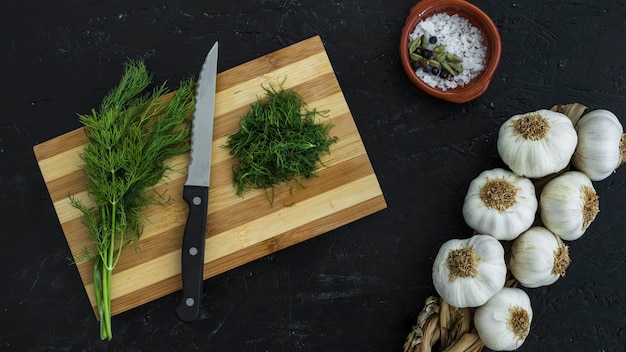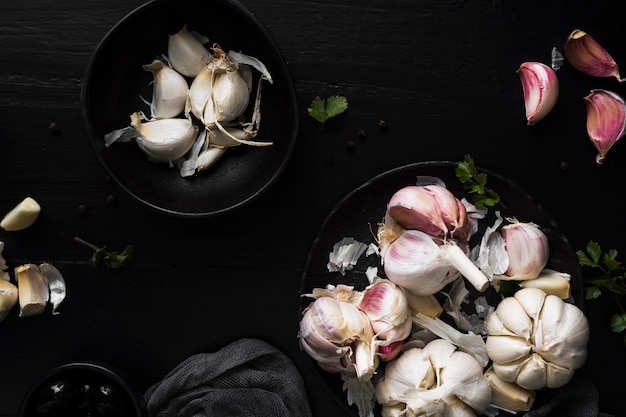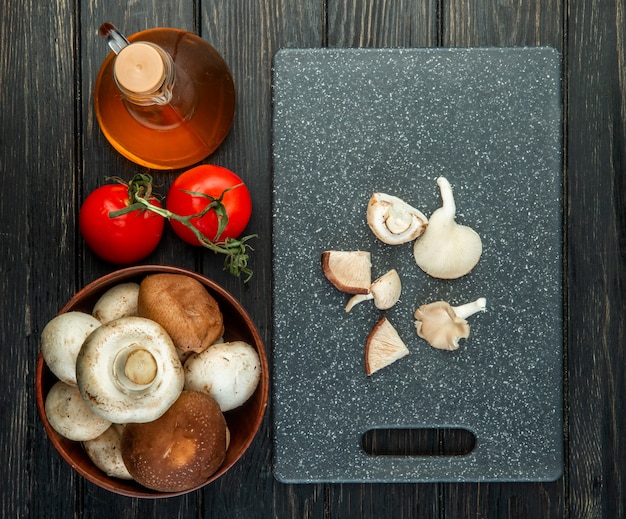Part 1: The Garlic Primer: Choosing and Prepping

Selecting the Perfect Garlic
Just like you wouldn't use any old ingredient for a special dish, you want to make sure you're starting with the best possible garlic. So, how do you choose the right bulb?- Firmness is Key: Imagine squeezing a ripe avocado – you want that same firmness when you're selecting garlic. A good bulb should feel solid and weighty, not soft or squishy. This indicates freshness and peak flavour.
- Avoid Bruised Bulbs: Bruises can affect the garlic's flavour and aroma, so give those a miss. Look for bulbs that are smooth and unblemished.
- Keep an Eye Out for Sprouting: A small sprout is generally okay, but if the garlic has sprouted significantly, it's a sign that it's getting a bit old. The flavour might be slightly compromised.
Prepping Your Garlic for Cooking
Now, you've got your perfect garlic; it's time to get down to business and prep it for cooking. While I'm not one to shy away from a good old-fashioned knife, there's no denying that a garlic press can be a real time-saver!- Separating the Cloves: Gently separate the cloves from the bulb, giving them a little twist to loosen them up. No need to be too forceful, just a gentle nudge will do the trick.
- Peeling the Cloves: This is where things can get a little messy, but here's my go-to method: Flatten each clove with the flat side of a chef's knife, then gently peel off the papery skin. If you're feeling fancy, a paring knife can provide a more precise peel.
- Chopping or Mincing: Now for the final step: decide whether you want a finer garlic flavour or larger pieces. For a more intense garlic taste, mince the cloves finely. For a slightly less potent flavour, chop the cloves into smaller pieces.
Part 2: Unleashing the Garlic Flavour: Cooking Methods

1. Sautéing: The Everyday Essential
Sautéing garlic is a staple in my kitchen. It's quick, easy, and delivers that vibrant, fresh garlic flavour we all crave. Just a few minutes in a hot pan, and you've got a fragrant boost for your dish.Top Tip
For that perfect sautéed garlic, I always use a neutral oil with a high smoke point, like sunflower oil or grapeseed oil. Olive oil, while delicious, has a lower smoke point and can easily burn, leaving a bitter taste.
How to Sauté Garlic:
1. Heat your pan: Set your pan over medium heat, and let it warm up for a few minutes. 2. Add the oil: Add your oil of choice, and let it heat up before adding the garlic. 3. Sauté until fragrant: Add your minced or chopped garlic and sauté for about 30 seconds to a minute, until it becomes fragrant and turns a beautiful golden color.2. Roasting: Bringing Out the Sweetness
Roasting garlic is a revelation! It transforms the sharp, pungent flavour into something mellow and sweet. It's perfect for adding depth and complexity to soups, stews, sauces, and even for making those decadent garlic spreads.How to Roast Garlic:
1. Preheat your oven: Set your oven to 180°C (350°F) and let it preheat thoroughly.2. Prepare the garlic: Cut the top off a whole head of garlic, exposing the cloves. 3. Drizzle and wrap: Drizzle the garlic with olive oil, sprinkle with salt and pepper, and wrap the head tightly in foil. 4. Roast until soft: Place the wrapped garlic in the oven and roast for 30-40 minutes, until the cloves are soft and golden.3. Confiting: The Luxury Treat
Confiting garlic is like giving it a spa day – it's a slow and gentle method that results in garlic that's incredibly tender and bursting with flavour.How to Confit Garlic:
1. Combine garlic and oil: In a saucepan, combine your garlic cloves with a good quality olive oil, ensuring that the garlic is fully submerged in the oil.2. Simmer slowly: Simmer the garlic over very low heat for 30-45 minutes, or until the cloves are soft and translucent.4. Infusing: A Subtle Touch
Infusing garlic is a more subtle approach, perfect for creating flavorful oils or vinegars that can add a delicate touch to your dishes.How to Infuse Garlic:
1. Combine ingredients: Place your garlic cloves in a clean, airtight jar, and then fill the jar with your choice of oil or vinegar. 2. Allow to infuse: Let the mixture infuse in a cool, dark place for at least a week, shaking the jar occasionally to ensure the flavours blend evenly.5. Stir-Frying: A Speedy Solution
Stir-frying garlic is a quick and easy way to add a burst of flavour to your stir-fry dishes.How to Stir-Fry Garlic:
1. Heat your wok: Heat a wok or a large skillet over high heat. 2. Add the oil: Add your oil of choice, and let it heat up before adding the garlic.3. Stir-fry until fragrant: Add your garlic and stir-fry for just a few seconds until it becomes fragrant and releases its aroma.Part 3: Beyond the Basics: Garlic Tips and Tricks

1. The Art of Garlic Storage
Fresh garlic is always best, but sometimes you end up with a surplus. Here's how to keep it fresh and flavorful for longer.- Store in a cool, dark place: Avoid storing garlic in the refrigerator. The cold, dry environment can actually dry it out. Instead, keep your garlic in a cool, dark place, like a pantry or a cupboard.
- Keep it whole: Storing garlic whole helps it stay fresh for longer. You can separate the cloves when you're ready to use them.
- Use a garlic keeper: If you're looking to keep your garlic for a longer period, a garlic keeper is a great investment. These containers create a more humid environment, helping to preserve the garlic's freshness and flavour.
2. The Magic of Garlic Powder
Let's face it, there are times when fresh garlic isn't readily available. That's when garlic powder comes in handy. It's a pantry staple in my kitchen and a great alternative to fresh garlic.- Add it at the beginning: Garlic powder works best when added at the beginning of cooking, giving it time to release its flavour and meld with the other ingredients.
- Use it sparingly: A little goes a long way! Start with a small amount and add more to taste, as garlic powder is much more concentrated than fresh garlic.
- Combine with fresh garlic: For extra depth of flavour, try using a combination of fresh garlic and a pinch of garlic powder. It's a winning combination!
3. The Versatility of Garlic Paste
Garlic paste is a godsend for busy cooks. It's a concentrated burst of garlic flavour, perfect for adding a quick touch of flavour to sauces, marinades, and dips.- Ideal for sauces and marinades: Garlic paste adds a wonderful depth of flavour to sauces, marinades, and even spreads, giving them that unmistakable garlic punch.
- Less mess, less fuss: No peeling or chopping required! It's so convenient for those times when you just need a quick garlic fix.
- Use it sparingly: Garlic paste is concentrated, so use it sparingly. Start with a small amount and adjust to taste.
Part 4: Garlic and Health: A Closer Look
Garlic isn't just about flavour; it's a nutritional powerhouse! It's packed with antioxidants, anti-inflammatory properties, and a host of other health benefits. Of course, always consult your doctor before making any significant changes to your diet.- Boosts immunity: Garlic contains compounds that can help boost the immune system, making it easier to fight off infections and stay healthy.
- May lower blood pressure: Studies have shown that garlic may help lower blood pressure, potentially reducing the risk of heart disease.
- Good for gut health: Garlic contains prebiotics, which are types of fibre that promote the growth of beneficial bacteria in your gut. This can help improve digestion and overall gut health.
- May help with cancer prevention: Some research suggests that garlic may have anti-cancer properties, but more research is needed in this area.
Part 5: A World of Garlic Recipes
Garlic is the star of countless delicious dishes, from simple weeknight dinners to extravagant feasts. Here are a few of my personal favourites that showcase garlic's versatility and flavour.1. Garlic Bread: A Classic for a Reason
Garlic bread! The mere mention of it evokes images of golden, crispy bread with that irresistible garlic aroma. It's a classic for a reason, and it's a dish that's surprisingly easy to make.Here's a simple recipe:
- Slice the baguette: Cut a baguette into thick slices, about ?? inch thick.
- Prepare the garlic butter: Combine softened butter with minced garlic, salt, and pepper. You can add other herbs like parsley or oregano for extra flavour.
- Spread the mixture: Generously spread the garlic butter onto each slice of bread.
- Bake until golden: Place the bread slices on a baking sheet and bake in a preheated oven until they are golden brown and crispy.
2. Garlic-Roasted Chicken: A Perfect Weeknight Dinner
This dish is a true crowd-pleaser, and it's perfect for a weeknight dinner. The roasted garlic infuses the chicken with a beautiful depth of flavour.Here's what you need:
- A whole chicken: Choose a whole chicken, about 3-4 pounds.
- Garlic cloves: About 4-6 garlic cloves, minced.
- Olive oil: About 2 tablespoons of olive oil.
- Salt and pepper: To taste.
- Lemon wedges: For serving.
Instructions:
- Preheat your oven: Set your oven to 200°C (400°F) and let it preheat thoroughly.
- Rub the chicken: In a bowl, combine the olive oil, minced garlic, salt, and pepper. Rub this mixture all over the chicken, making sure to get under the skin.
- Roast until cooked: Place the chicken in a roasting pan and roast for 1 hour and 15 minutes, or until the internal temperature reaches 165°F.
- Serve with lemon wedges: Let the chicken rest for 10 minutes before carving and serving with lemon wedges.
3. Garlic shrimp scampi: A Taste of Italy
This is a classic Italian dish that is full of flavour, and the garlic and lemon are a match made in heaven! It's also very easy to prepare.Ingredients:
- Shrimp: About 1 pound of shrimp, peeled and deveined.
- Garlic cloves: About 4-5 garlic cloves, minced.
- White wine: About ?? cup of dry white wine.
- Olive oil: About 2 tablespoons of olive oil.
- Lemon juice: About 2 tablespoons of fresh lemon juice.
- Parsley: About 2 tablespoons of chopped fresh parsley.
- Salt and pepper: To taste.
- Pasta: About 1 pound of your favourite pasta (linguine or fettuccine work well).
Instructions:
- Cook the pasta: Cook the pasta according to package directions.
- Prepare the shrimp: While the pasta is cooking, heat the olive oil in a large skillet over medium heat. Add the minced garlic and sauté for 1 minute, until fragrant.
- Cook the shrimp: Add the shrimp to the skillet and cook for 2-3 minutes per side, until they are pink and cooked through.
- Deglaze the pan: Pour in the white wine and scrape the bottom of the pan to release any browned bits.
- Add the lemon juice: Add the lemon juice, parsley, salt, and pepper. Stir to combine.
- Toss with the pasta: Add the cooked pasta to the skillet and toss to coat it in the sauce and shrimp.
- Serve immediately: Serve the garlic shrimp scampi hot, garnished with additional parsley if desired.
Part 6: Garlic and Wine: A Match Made in Heaven
Garlic and wine? Absolutely! Garlic's robust flavour pairs wonderfully with a variety of wines.Here are some of my favourite pairings:
| Garlic Dish | Recommended Wine |
|---|---|
| Garlic-Roasted Vegetables | Sauvignon Blanc, Pinot Grigio |
| Garlic Shrimp Scampi | Pinot Grigio, Vermentino |
| Garlic Bread | Chardonnay, Pinot Grigio |
| Garlic Soup | Pinot Noir, Merlot |
| Garlic-Infused Oil | Syrah, Cabernet Sauvignon |
Experiment with different pairings to discover your own favourites!
Part 7: A Word of Caution: Garlic Breath
Let's be honest, we've all been there – the dreaded garlic breath that seems to linger even after brushing our teeth. While it's a small price to pay for deliciousness, here are a few tips to help minimize the garlic breath:- Drink plenty of water: Water helps flush out the compounds that cause garlic breath. Sip on water throughout the day, especially after eating garlic-heavy meals.
- Chew on parsley: Parsley has a natural deodorizing effect. Chewing on some fresh parsley after a meal can help freshen your breath.
- Use a mouthwash: A good mouthwash can help neutralize garlic odour.
- Avoid coffee and alcohol: These beverages can intensify garlic breath, so it's best to avoid them after a garlic-rich meal.
Part 8: FAQs: Your Garlic Questions Answered
Here are some common questions about garlic:
1. Can you eat garlic raw?
Absolutely! Raw garlic has a stronger, sharper flavour than cooked garlic. It's often used in dips, sauces, and salads. Just be prepared for the potential garlic breath!
2. Is it okay to eat garlic every day?
Moderation is key, but eating garlic regularly can be beneficial for your health. However, if you have any health concerns, it's always best to consult your doctor.
3. How can I reduce the strong flavour of garlic?
To mellow out the flavour of garlic, try roasting or confiting it. These methods help to bring out the sweetness of the garlic and reduce its sharpness.
4. What are some good substitutes for garlic?
If you're allergic to garlic or simply don't like the flavour, there are a few substitutes you can use:
- Shallots: Shallots have a milder, sweeter flavour than garlic and are often used in place of garlic in dishes like french onion soup.
- Onions: Onions can be used in place of garlic, but they have a stronger flavour. They are versatile and can be used in both sweet and savory dishes.
- Leeks: Leeks have a slightly sweet and savory flavour that can be used in place of garlic. They are often used in soups and stews.
5. How do I remove the smell of garlic from my hands?
Rub your hands with stainless steel for a few minutes. The stainless steel helps to neutralize the garlic compounds.
Conclusion
And there you have it! Your comprehensive guide to cooking garlic, from choosing the perfect bulb to mastering a variety of cooking methods. Whether you're a seasoned chef or just starting your culinary journey, I hope this guide has empowered you to embrace the wonderful world of garlic and all its flavour possibilities. So, grab your garlic, get creative, and enjoy the flavour and health benefits of this magnificent ingredient. Happy cooking!
Everyone is watching

Prime Rib Roast Cooking Time Chart: Per Pound Guide
Cooking TipsPrime rib roast. Just the name conjures images of lavish dinners, crackling fires, and hearty laughter. It’s ...

How Long to Bake Potatoes in the Oven (Perfect Every Time)
Cooking TipsBaked potatoes are a staple in my kitchen. They're incredibly versatile, delicious, and surprisingly easy to m...

Perfect Rice Every Time: The Ultimate Guide to Cooking Rice
Cooking TipsAs a self-proclaimed foodie, I've always been a bit obsessed with rice. It's the foundation of countless cuisi...

The Ultimate Guide to Cooking Asparagus: Tips, Techniques, and Recipes
Cooking TipsAsparagus. The mere mention of this spring delicacy conjures up images of vibrant green spears, crisp and burs...

Ultimate Guide to Cooking the Perfect Thanksgiving Turkey
Cooking TipsThanksgiving. Just the word conjures up images of overflowing tables laden with delicious food, the scent of r...
